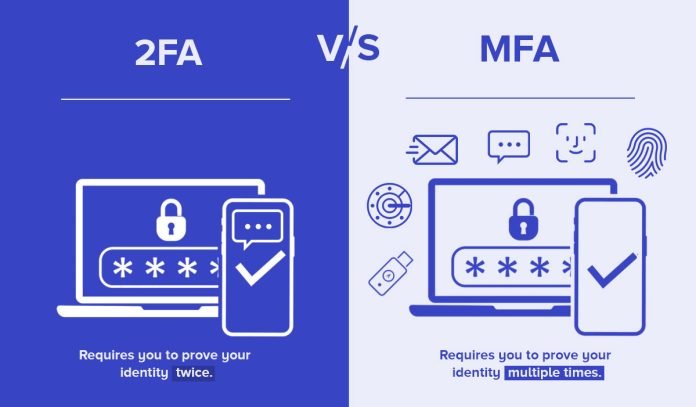Last Updated on March 1, 2023 by
The mobile app market is growing and becoming more competitive. With so many apps in the market, it is hard for an app to stand out from the rest. It’s crucial for an app to be perfect and provide a high level of security. To ensure the security of your online applications, you can use the MFAuth app for your 2-Factor Authentication needs”
MFAuth is used with a password or fingerprint to authenticate a user. Factor authentication uses biometric data such as voice, face, or iris scans to authenticate users instead of passwords.
MFAuth is a security protocol that provides two-factor authentication. It provides an additional layer of security to the user’s account by requiring them to enter a password and one-time use code generated by the app. MFAuth allows for more flexibility by providing easy access to your codes through Android, iOS apps or through web interface including extensions for Chrome & Firefox. It keeps your account data backed up to the cloud and always in sync throughout the platforms.
The relationship between 2-Factor Authentication is straightforward: MFAuth requires users to enter a password and one-time use code generated by the app.
Table of Contents
MFAuth is different than Factor Authentication. MFAuth is the implementation of digital identity that can be used on large-scale scenarios. While it’s not new, integrating it with 2- Factor Authentication is a completely new concept. The two work together to make sure that the user has a higher level of security by verifying the authenticity of their identity.
This article discusses how 2-Factor authentication and MFAuth work together to provide a higher level of security for users. It also talks about how these methods are being used in different industries, such as banking, healthcare, and education.
A factor is any action, whether authenticated or not, that an individual might do to prove their identity. Factors can include a password, a code generated by a hardware key fob, fingerprint scans, or iris scans. An authorization is the act of granting access to something based on the current level of authentication. For example, if someone only has to enter their password in order to gain access, then the authentication level is low, and they’re not yet authorized. If they don’t enter a valid password or a key fob code and are still allowed in, then their current level of authentication is high enough that they’ve been authorized.
How to Use 2 Factor Authentication on Social Media Accounts
Two-factor authentication is an additional layer of security that requires two pieces of information to access a service. The first piece of information is the password, and the second piece of information is a unique code sent to your phone or computer.
This type of security provides an extra layer of protection against phishing and other forms of identity theft. It’s also useful in preventing unauthorized transactions, such as those made with stolen credit cards or wire transfers.
Two-factor authentication can be used for a variety of different services, including online banking, email accounts, social media accounts, and more.
Many social media platforms offer two-factor authentication as an additional layer of security. This means that you will need a password, which will be sent to your phone via text message, and then you will need another password, which is sent to your email address.
If you are using Facebook or Twitter as an example, this would mean that someone would need your password plus their phone number in order to gain access to your account
Two-factor authentication is a security measure that requires both a password and an additional code sent to the user’s phone. It is used for login verification on social media accounts, email, and other online accounts.
With the rise of cybercrime, it is important to have a security app that supports 2FA. This will not only help you protect your data but also provide peace of mind and make sure that you are always protected.
When you use a security app with 2FA support, you will be able to enjoy the following benefits:
- You can protect your data from hackers
- You can verify your identity when logging into an online account or service
- You can enjoy the peace of mind knowing that no one else has access to your account or personal information
The MFAuth- 2 Factor Authenticator secure many social media platforms such as Snapchat, Instagram, Facebook, Twitter, etc. So, the next thing is to learn How to Turn ON 2 Factor Authenticator for Snapchat.
It is a very easy and secured feature in snapchat.
- Click on my profile, you will find settings there.
- Go to settings and tap 2Factor Authentication.
- Download the mobile app to set this up.
- And then tap continue to complete the whole process.
Understanding the Relationship between MFAuth and 2-Factor Authentication
MFAuth uses Time-based one-time password (TOTP) protocol used by standard 2-Factor apps along with a secure mechanism to keep your secret keys safe at all times. It is secure because it can require you to use your biometrics to lock your safe and keep it secure at all times.
Not only this, the safe is locked with the authentication you provide and only you know. So, your data can only be accessible by you at all times and cannot be opened by anyone else. This makes it impossible for hackers to steal your 2FA codes even if you lose your phone.
Advantages of Using a Security App that Supports Two Factor Authentication: –
With the rise of cybercrime, it is important to have a security app that supports 2FA. This will not only help you protect your data but also provide peace of mind and make sure that you are always protected.
When you use a security app with 2FA support, you will be able to enjoy the following benefits:
- You can protect your data from hackers
- You can verify your identity when logging into an online account or service
- You can enjoy the peace of mind knowing that no one else has access to your account or personal information
- Read More: Everything Your Business Needs to Know About SCA Compliance






















